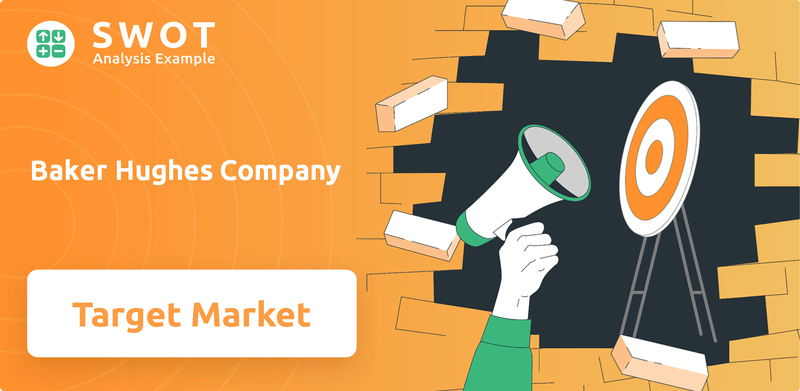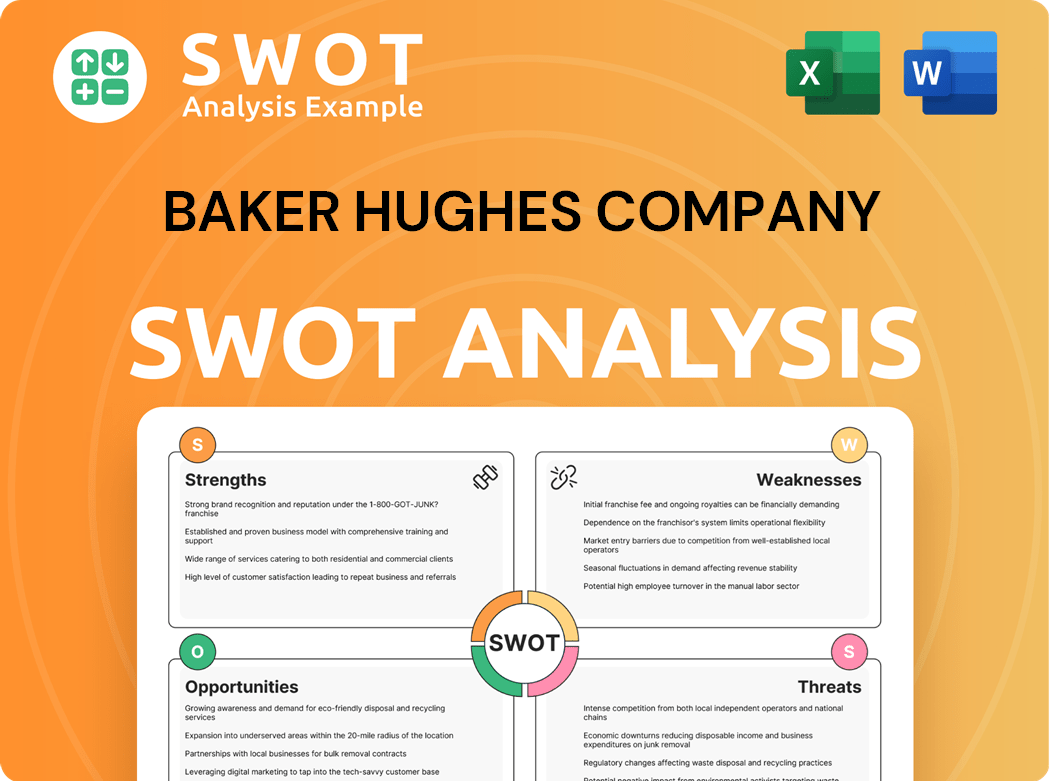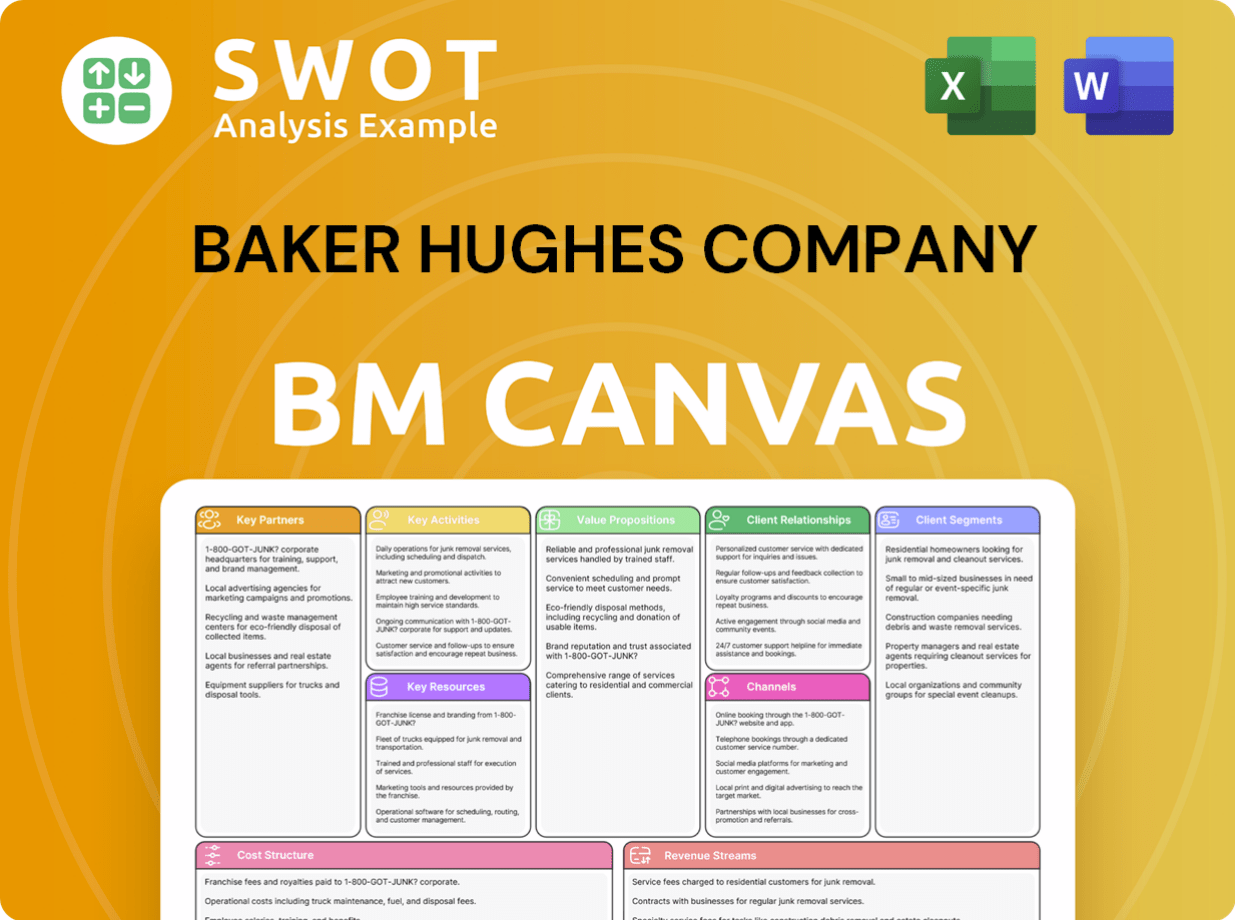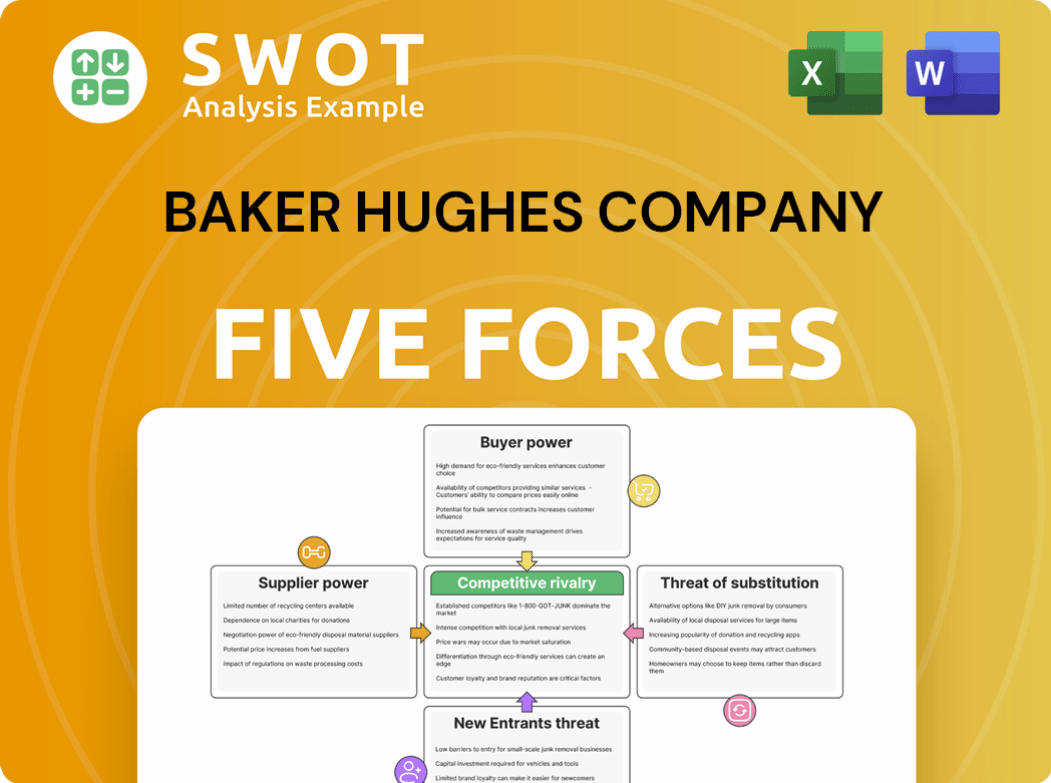Baker Hughes Company Bundle
Who Does Baker Hughes Serve in Today's Evolving Energy Landscape?
Understanding the Baker Hughes Company SWOT Analysis is crucial, but even more so is knowing its customers. In a world rapidly transitioning towards sustainable energy, Baker Hughes' success hinges on a deep understanding of its customer demographics and target market. This knowledge is paramount for strategic decision-making and ensuring the company remains at the forefront of the energy revolution.

Baker Hughes, originally rooted in the Oil and Gas Industry, has broadened its scope to include a diverse range of clients. This shift reflects the company's adaptation to the changing demands of the Energy Sector Analysis. Analyzing the Baker Hughes customer base breakdown reveals a strategic evolution, moving beyond traditional oilfield services to embrace new energy frontiers and industrial applications. Understanding who Baker Hughes' primary customers are is key to grasping the company's future trajectory.
Who Are Baker Hughes Company’s Main Customers?
Understanding the Customer Demographics of Baker Hughes is crucial for grasping its market position. As a Business-to-Business (B2B) entity, the company's primary focus lies within the energy and industrial sectors. This approach contrasts with Business-to-Consumer (B2C) models, highlighting a different set of market dynamics.
The Baker Hughes Target Market encompasses a diverse global clientele. Key customers include major integrated oil companies (IOCs), national oil companies (NOCs), independent oil and gas producers, and various industrial operators. These entities are typically large corporations with substantial capital expenditure budgets, influencing the company's strategic direction.
The company's customer base has been evolving. The shift is driven by global energy trends and the company's strategic investments in new energy technologies. For instance, the company is actively involved in providing compression technology for LNG projects, a sector experiencing significant growth as global demand for natural gas continues. For more insights, you can explore the Growth Strategy of Baker Hughes Company.
The primary customer segments for Baker Hughes include major integrated oil companies (IOCs) such as ExxonMobil, Shell, and BP. National oil companies (NOCs) like Saudi Aramco and ADNOC also constitute a significant portion of the customer base. Independent oil and gas producers and various industrial operators are also key clients.
Within these organizations, decision-making is complex, involving engineers, project managers, procurement specialists, and executive leadership. These teams evaluate technological solutions, project feasibility, and financial implications. Understanding this process is vital for effective sales and marketing strategies.
Fastest-growing segments are increasingly tied to the energy transition, including customers investing in liquefied natural gas (LNG) infrastructure, carbon capture utilization and storage (CCUS) projects, hydrogen production and transport, and industrial decarbonization initiatives. These areas highlight the company's adaptability and strategic foresight.
Baker Hughes has witnessed a notable shift in its target segments, moving beyond solely upstream oil and gas exploration and production. This shift has been prompted by global energy trends, increased environmental regulations, and the company's own strategic investments in new energy technologies. The company's 2024 outlook also emphasized continued investment in gas technology and new energy solutions, further diversifying its customer base.
Key criteria for segmenting Baker Hughes' B2B customers include the size of operations, geographic location, technological maturity, strategic priorities, and financial capacity. These factors help tailor solutions and services to meet specific customer needs. The company's focus on these criteria drives its market segmentation strategies.
- Size of Operation: Large-scale versus smaller operations.
- Geographic Location: Different regions have varying energy demands and regulations.
- Technological Maturity: Adoption rates of new technologies vary by customer.
- Strategic Priorities: Focus on production, emissions reduction, or digital transformation.
- Financial Capacity: Influences investment decisions and project scope.
Baker Hughes Company SWOT Analysis
- Complete SWOT Breakdown
- Fully Customizable
- Editable in Excel & Word
- Professional Formatting
- Investor-Ready Format

What Do Baker Hughes Company’s Customers Want?
Understanding the customer needs and preferences is crucial for the success of any company, and for Baker Hughes Company, this is especially true. The firm's customers, largely comprising major energy and industrial enterprises, have complex needs that go beyond simple product purchases. Their purchasing decisions are influenced by factors like reliability, efficiency, safety, and technological innovation.
The primary drivers for choosing Baker Hughes' offerings often stem from the critical nature of their operations; failures can lead to substantial financial losses, environmental damage, and reputational harm. Therefore, trust in the vendor's expertise, proven track record, and responsive support are paramount. Baker Hughes addresses common pain points such as optimizing production in mature fields, reducing methane emissions, enhancing drilling efficiency in challenging geological formations, and improving the uptime of critical rotating equipment.
Baker Hughes' customers are primarily driven by the need for solutions that enhance hydrocarbon recovery rates, reduce operational expenditures, minimize environmental impact, and improve worker safety. These customers are in the Oil and Gas Industry and the Energy Sector. They seek technologies that integrate seamlessly with existing infrastructure, ensuring operational uptime and regulatory compliance. The company's marketing often emphasizes its integrated solutions capability, highlighting how its diverse portfolio can address complex challenges across the energy value chain.
Customers value reliability to minimize downtime and associated financial losses. This includes robust equipment and responsive support services. In the oil and gas sector, a single day of downtime can cost millions.
Customers prioritize solutions that enhance operational efficiency, such as technologies that optimize production rates and reduce energy consumption. This is particularly important in mature oil fields.
Safety is a critical concern, with customers seeking solutions that improve worker safety and comply with stringent regulatory requirements. This includes technologies that reduce the risk of accidents and environmental incidents.
Customers are increasingly looking for advanced technologies, including digital solutions for predictive maintenance and performance optimization. The demand for these solutions is growing rapidly.
There's a growing demand for solutions that reduce environmental impact, such as carbon capture technologies and methane emission reduction systems. This is driven by both regulatory pressures and sustainability goals. In 2024, the global carbon capture and storage (CCS) market was valued at approximately $3.5 billion, and it is projected to reach $12.6 billion by 2029.
Customers consider the total cost of ownership, including initial investment, operational costs, and maintenance expenses. This includes the cost of equipment, installation, and ongoing maintenance.
Baker Hughes' customer base breakdown reveals a focus on addressing specific pain points and market trends. The company's customer acquisition strategy emphasizes providing solutions that align with evolving industry demands. Key customer needs include:
- Optimizing production in mature fields through advanced technologies.
- Reducing methane emissions to meet environmental regulations and sustainability goals.
- Enhancing drilling efficiency in challenging geological formations.
- Improving the uptime of critical rotating equipment through predictive maintenance and digital solutions.
- Providing integrated solutions to address complex challenges across the energy value chain.
Baker Hughes Company PESTLE Analysis
- Covers All 6 PESTLE Categories
- No Research Needed – Save Hours of Work
- Built by Experts, Trusted by Consultants
- Instant Download, Ready to Use
- 100% Editable, Fully Customizable

Where does Baker Hughes Company operate?
The geographical market presence of Baker Hughes is extensive, spanning across major energy-producing and consuming regions worldwide. The company's operations are strategically distributed across North America, Latin America, Europe, Africa, the Middle East, and the Asia Pacific. This wide reach allows it to serve a diverse customer base within the Oil and Gas Industry and broader Energy Sector Analysis.
Historically, regions rich in hydrocarbon resources have been key strongholds for Baker Hughes. These include North America, particularly the Permian Basin, and the Middle East, with countries like Saudi Arabia and the UAE. Strong presence in Africa, such as Nigeria and Angola, also contributes significantly to its geographical footprint. The company's ability to adapt to varying regional demands and regulatory environments is crucial for its sustained global success.
Baker Hughes tailors its offerings and marketing strategies to align with the specific needs and preferences of each region. This localized approach includes establishing regional offices, employing local talent, and adapting service models to comply with local regulations and cultural nuances. The company's commitment to localization is evident in its region-specific training programs and partnerships with local suppliers, which enhance its ability to serve its Customer Demographics Baker Hughes effectively.
Baker Hughes segments its market based on geographical regions, customer types (e.g., national oil companies, international oil companies), and project types (e.g., exploration, production, LNG). This segmentation strategy enables the company to tailor its products and services to meet specific customer needs within each segment.
North America remains a significant market, with a focus on optimizing existing assets and digital transformation. The Middle East and Asia Pacific regions are experiencing growth due to infrastructure development and increasing energy demands. Europe is prioritizing emissions reduction and sustainable energy solutions.
Baker Hughes is actively pursuing opportunities in regions investing heavily in LNG infrastructure, such as Qatar and Mozambique. The company is also focusing on countries developing hydrogen economies. Strategic withdrawals or reduced focus may occur in areas facing geopolitical instability or declining mature fields.
The company's Q4 2023 earnings report highlighted strong international demand for its oilfield services and equipment, indicating continued global engagement beyond North America. This diversification reflects the company's ability to adapt to evolving market dynamics and global energy transitions.
The company’s strategic focus includes adapting to the global energy transition, with significant investments in LNG and hydrogen projects. Understanding the Baker Hughes Target Market requires an awareness of these shifts. For more insights into the company's financial strategies, consider reading about the Revenue Streams & Business Model of Baker Hughes Company.
- North America: Focus on digital transformation and emissions reduction.
- Middle East: Strong demand due to ongoing oil and gas projects.
- Asia Pacific: Growth driven by infrastructure development and energy demand.
- Europe: Emphasis on sustainable energy solutions and decarbonization.
Baker Hughes Company Business Model Canvas
- Complete 9-Block Business Model Canvas
- Effortlessly Communicate Your Business Strategy
- Investor-Ready BMC Format
- 100% Editable and Customizable
- Clear and Structured Layout

How Does Baker Hughes Company Win & Keep Customers?
Customer acquisition and retention strategies are crucial for the success of any business, and the [Company Name] is no exception. The company, operating within the Oil and Gas Industry, employs a multifaceted approach tailored to its B2B model. This involves leveraging various marketing channels, prioritizing direct sales, and building strong customer relationships to maintain its market position and drive growth. Understanding the intricacies of its customer base and the strategies employed offers valuable insights into the company's overall market approach.
The company's strategies are designed to address the complex needs of its clients. These strategies involve a combination of technological leadership, commitment to sustainability, and the ability to offer integrated solutions. The company's approach to customer acquisition and retention is particularly relevant in the context of the evolving energy landscape, where sustainability and operational efficiency are increasingly important. The company's focus on innovation and customer-centric solutions is key to its long-term success.
Customer acquisition strategies center on targeted marketing efforts. These include participation in industry-specific trade shows like CERAWeek and ADIPEC, the use of technical publications, and digital marketing campaigns. Direct sales, supported by a global sales force, are a cornerstone of their approach, emphasizing technical consultations and long-term contract negotiations. The company's customer acquisition strategy is a blend of traditional and digital methods, reflecting the industry's need for both personal relationships and technological expertise.
The company actively participates in major industry events such as CERAWeek and ADIPEC. These events provide opportunities for direct engagement with potential customers and showcasing the latest technological advancements. This approach is vital for building relationships and understanding customer needs within the Oil and Gas Industry.
Digital marketing efforts include corporate websites, LinkedIn campaigns, and targeted online advertising. These strategies are designed to reach a broad audience and generate leads. The company leverages digital platforms to highlight its solutions and engage with potential customers effectively.
A significant portion of the company's customer acquisition relies on direct sales through a globally distributed sales force. This involves in-depth technical consultations and customized solution proposals. Direct engagement is crucial for understanding and meeting the complex needs of clients.
The company utilizes technical publications to disseminate information about its products and services. These publications help to educate potential customers about the company's offerings. This strategy is particularly important for showcasing the company's expertise and building credibility within the industry.
Customer retention is a priority, built on delivering high-quality products, exceptional after-sales support, and continuous innovation. The company emphasizes personalized experiences, assigning dedicated account managers and technical experts. Data-driven insights from CRM systems are used to segment customers, track interactions, and identify upselling and cross-selling opportunities. These efforts are designed to foster long-term relationships and increase customer lifetime value. For more information on the company's financial performance and ownership structure, consider reading Owners & Shareholders of Baker Hughes Company.
The company focuses on delivering reliable and high-performing products and services. This commitment is crucial for retaining customers and building trust. High-quality offerings ensure customer satisfaction and encourage repeat business.
Providing excellent after-sales support is a key component of the company's retention strategy. This includes responsive customer service and technical assistance. Effective support helps maintain customer satisfaction and loyalty.
The company invests in continuous innovation to meet evolving customer needs. This includes developing new technologies and improving existing products. Innovation is crucial for staying competitive and retaining customers.
Dedicated account managers and technical experts provide personalized support. This approach helps build strong relationships and address specific customer challenges. Personalized experiences enhance customer satisfaction and loyalty.
CRM systems are used to segment customers and track interactions. This data informs tailored marketing campaigns and service offerings. Data-driven insights help the company understand and meet customer needs more effectively.
Identifying opportunities for upselling and cross-selling enhances customer value. This approach involves offering additional products and services that meet customer needs. Increased value helps strengthen customer relationships.
Baker Hughes Company Porter's Five Forces Analysis
- Covers All 5 Competitive Forces in Detail
- Structured for Consultants, Students, and Founders
- 100% Editable in Microsoft Word & Excel
- Instant Digital Download – Use Immediately
- Compatible with Mac & PC – Fully Unlocked

Related Blogs
- What are Mission Vision & Core Values of Baker Hughes Company Company?
- What is Competitive Landscape of Baker Hughes Company Company?
- What is Growth Strategy and Future Prospects of Baker Hughes Company Company?
- How Does Baker Hughes Company Company Work?
- What is Sales and Marketing Strategy of Baker Hughes Company Company?
- What is Brief History of Baker Hughes Company Company?
- Who Owns Baker Hughes Company Company?
Disclaimer
All information, articles, and product details provided on this website are for general informational and educational purposes only. We do not claim any ownership over, nor do we intend to infringe upon, any trademarks, copyrights, logos, brand names, or other intellectual property mentioned or depicted on this site. Such intellectual property remains the property of its respective owners, and any references here are made solely for identification or informational purposes, without implying any affiliation, endorsement, or partnership.
We make no representations or warranties, express or implied, regarding the accuracy, completeness, or suitability of any content or products presented. Nothing on this website should be construed as legal, tax, investment, financial, medical, or other professional advice. In addition, no part of this site—including articles or product references—constitutes a solicitation, recommendation, endorsement, advertisement, or offer to buy or sell any securities, franchises, or other financial instruments, particularly in jurisdictions where such activity would be unlawful.
All content is of a general nature and may not address the specific circumstances of any individual or entity. It is not a substitute for professional advice or services. Any actions you take based on the information provided here are strictly at your own risk. You accept full responsibility for any decisions or outcomes arising from your use of this website and agree to release us from any liability in connection with your use of, or reliance upon, the content or products found herein.